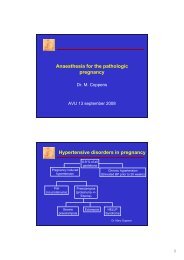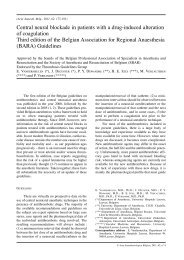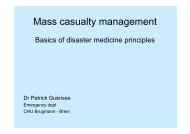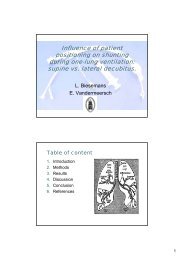Combined spinal epidural analgesia for labor and delivery
Combined spinal epidural analgesia for labor and delivery
Combined spinal epidural analgesia for labor and delivery
You also want an ePaper? Increase the reach of your titles
YUMPU automatically turns print PDFs into web optimized ePapers that Google loves.
110 M. VAN DE VELDE<br />
Fig. 1. — Onset time of <strong>analgesia</strong> following CSE or conventional<br />
<strong>epidural</strong> <strong>analgesia</strong> (minutes). Onset time is consistently<br />
shorter in CSE treated patients.<br />
<strong>epidural</strong> <strong>analgesia</strong> provides equally fast <strong>analgesia</strong><br />
(104).<br />
It is important to note, however, that although<br />
the onset time of <strong>epidural</strong> <strong>analgesia</strong> might be reasonable,<br />
the reported values are means. With<br />
<strong>epidural</strong> <strong>analgesia</strong>, a wide inter-patient variability<br />
exists with respect to onset time of <strong>analgesia</strong>,<br />
depending on parity, stage of <strong>labor</strong> <strong>and</strong> other relevant<br />
obstetrical <strong>and</strong> non-obstetrical factors.<br />
Especially during late <strong>labor</strong>, <strong>analgesia</strong> following an<br />
<strong>epidural</strong> injection is often delayed, <strong>and</strong> only successful<br />
if large doses are administered. With CSE,<br />
onset time is short in all patients irrespective of the<br />
stage of <strong>labor</strong> <strong>and</strong> other factors. The dose of local<br />
anesthetic only needs slight increases when <strong>labor</strong> is<br />
significantly advanced.<br />
Quality of pain relief : VAS scores, satisfaction <strong>and</strong><br />
anesthetist intervention rate<br />
Several trials demonstrated lower VAS scores<br />
<strong>for</strong> <strong>labor</strong> pain with CSE as compared to <strong>epidural</strong><br />
<strong>analgesia</strong> (36, 62, 77, 154). However, other comparative<br />
trials could not demonstrate a difference in<br />
VAS scores <strong>for</strong> pain (69, 104, 132). No trials report<br />
higher VAS scores with CSE. Most likely, especially<br />
during the first 30 to 60 minutes, VAS scores are<br />
lower when patients receive CSE.<br />
Most anesthesiologists would agree that CSE<br />
provides better quality <strong>analgesia</strong> throughout the<br />
course of <strong>labor</strong> (84). Vernis <strong>and</strong> co-workers demonstrated<br />
that less patients reported unilateral <strong>analgesia</strong><br />
whith CSE as compared to conventional <strong>epidural</strong><br />
<strong>analgesia</strong> (167). Interestingly, HESS et al. investigated<br />
the factors associated with breakthrough pain<br />
during neuraxial <strong>labor</strong> <strong>analgesia</strong> <strong>and</strong> found that<br />
patients treated with conventional <strong>epidural</strong> <strong>analgesia</strong><br />
were three times as likely to experience recurrent<br />
breakthrough pain as compared to CSE treated<br />
women (71). However, GOODMAN et al., in a<br />
prospective study, failed to corroborate the latter<br />
study (62). These authors noted that additional topups<br />
to treat breakthrough pain were requested by<br />
similar numbers of patients irrespective of the analgesic<br />
strategy used (62).<br />
The presence of a dural puncture may facilitate<br />
the passage of <strong>epidural</strong>ly administered drugs<br />
during maintenance of <strong>analgesia</strong> to the cerebro<strong>spinal</strong><br />
fluid. Such an effect has been reported, at<br />
least in animals (155). In patients, LEIGHTON et al.<br />
also reported that <strong>epidural</strong> bupivacaine blocked<br />
more dermatomes when administered following an<br />
initial dural puncture as compared to <strong>epidural</strong> bupivacaine<br />
administered without prior dural puncture<br />
(87). LEIGHTON et al. used a 24 <strong>and</strong> 27G <strong>spinal</strong><br />
needle. Cappiello <strong>and</strong> co-workers per<strong>for</strong>med a<br />
study in which the dura was per<strong>for</strong>ated with a 25G<br />
Whitacre needle, without any administration of<br />
<strong>spinal</strong> drugs (22). The control group had no dural<br />
puncture. In both groups, <strong>analgesia</strong> was initiated<br />
with an <strong>epidural</strong> local anesthetic/opioid mixture.<br />
Patients treated with a dural puncture had better<br />
sacral spread, shorter onset of <strong>analgesia</strong> <strong>and</strong> better<br />
quality pain relief. Thomas et al. per<strong>for</strong>med a similar<br />
study using a 27G Whitacre needle <strong>and</strong> could<br />
not find a difference between patients treated with<br />
or without a dural puncture (156). There<strong>for</strong>e, <strong>spinal</strong><br />
needle size may be important.<br />
Many studies report higher patient satisfaction<br />
with CSE (36, 37, 47, 162), while no studies report<br />
on the opposite.<br />
Local anesthetic consumption<br />
Despite similar or improved quality of <strong>analgesia</strong>,<br />
local anesthetic requirements are significantly<br />
reduced with CSE as compared to low dose conventional<br />
<strong>epidural</strong> techniques (36, 37, 77, 162, 167).<br />
Discussion remains whether this is the result of the<br />
omission of the initial <strong>epidural</strong> bolus or whether a<br />
© Acta Anæsthesiologica Belgica, 2009, 60, n° 2
















